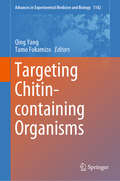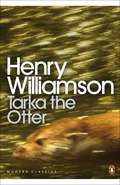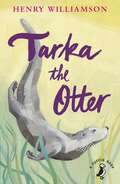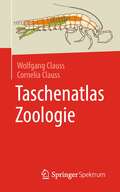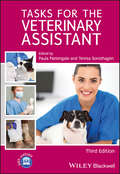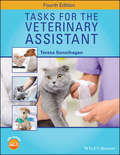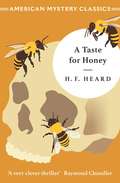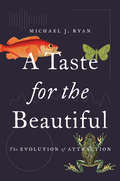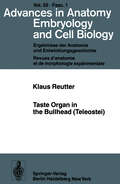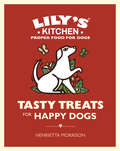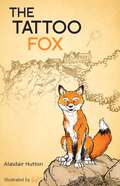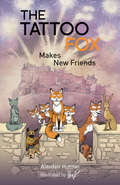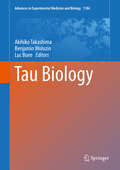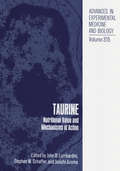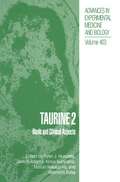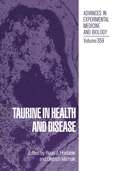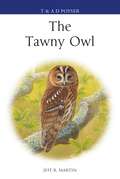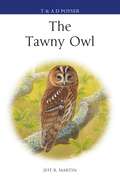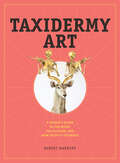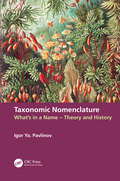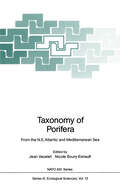- Table View
- List View
Targeting Chitin-containing Organisms (Advances in Experimental Medicine and Biology #1142)
by Qing Yang Tamo FukamizoThis book provides a comprehensive overview of chitin biology and chitin metabolism related enzymes. Chitin, the second most abundant biopolymer in nature after to cellulose, is a linear biopolymer composed of β-1,4-linked N-acetylglucosamine (GlcNAc), and an essential component in the exoskeletons of insects, mites, ticks and crustaceans, the egg shells of parasitic nematodes, and fungal cell walls. Although some chitin-containing organisms are a threat to human health, food safety and agricultural production, non-chitin containing organisms like humans, mammals and plants have an innate immune response to these hazardous organisms. The book provides researchers and students with information on the recent research advances concerning the biology of chitin-containing organisms as well as cross-talks between chitin-containing and non-chitin-containing organisms. Highlighting chitin remodeling enzymes and inhibitors, it also offers drug developers essential insights into designing specific molecules for the control of hazardous chitin-containing organisms.
Tarka the Otter: A Sunday Night Feature On The Author Of "tarka The Otter", Henry Williamson (Penguin Modern Classics)
by Henry Williamson Jeremy GavronIn the wild there is no safety. The otter cub Tarka grows up with his mother and sisters, learning to swim, catch fish - and to fear the cry of the hunter and the flash of the metal trap. Soon he must fend for himself, travelling through rivers, woods, moors, ponds and out to sea, sometimes with the female otters White-tip and Greymuzzle, always on the run. Eventually, chased by a pack of hounds, he meets his nemesis, the fearsome dog Deadlock, and must fight for his life.
Tarka the Otter: A Sunday Night Feature On The Author Of "tarka The Otter", Henry Williamson (A Puffin Book #37)
by Henry Williamson Annabel LargeA Puffin Book - stories that last a lifetime.Puffin Modern Classics are relaunched under a new logo: A Puffin Book. There are 20 titles to collect in the series, listed below, all with exciting new covers and child-friendly endnotes.TARKA THE OTTER is the classic story of an otter living in the Devonshire countryside which captures the feel of life in the wild as seen through the otter's own eyes. The story's atmosphere and detail make it easy to see why Tarka has become one of the best-loved creatures in world literature.Henry William Williamson was born in 1895 in Brockley, south-east London. The then semi-rural location provided easy access to the countryside, and he developed a deep love of nature throughout his childhood. He became a prolific author known for his natural and social history novels. He won the Hawthornden Prize for literatrure in 1928 for Tarka the Otter.
Taschenatlas Zoologie
by Wolfgang Clauss Cornelia ClaussDer erste Taschenatlas für die Zoologie - der komplette Bachelor-Lehrstoff im kompakten Doppelseitenformat. Dieses Buch bietet eine systematische Zusammenstellung der gesamten Lehrinhalte der Allgemeinen und wie auch der Speziellen Zoologie. Auf etwa 180 thematisch abgeschlossenen Doppelseiten werden die Inhalte zu einzelnen Themen kompakt, übersichtlich und in Ergänzung zum Text mit großformatigen Farbabbildungen präsentiert. Somit wird ein bündiger, zum Lernen, lehren und nachschlagen bestens geeigneter Überblick über die Zoologie geboten. Der Taschenatlas eignet sich folglich ideal für alle Studierenden der Biologie und verwandter Fächer, wie auch für Lehrer der Biologie und als Nachschlagewerk für jede an der Vielfalt der Tierwelt interessierte Person.
Tasks for the Veterinary Assistant
by Paula PattengaleTasks for the Veterinary Assistant, Third Edition provides practical, step-by-step instructions for preparing and performing a wide range of veterinary assisting tasks. With expanded coverage of large animal and exotic restraint, anatomy and physiology, nutrition and feeding, digital radiography, and electronic medical records and client communication, this revised edition now includes why and when to perform each task with the preparation and procedure information. The book includes everything from appearance and professional language to equipment maintenance and dental and surgical assisting, making it equally useful for learning new techniques or as a memory refresher. Offering a detailed, comprehensive guide to all aspects of veterinary assisting, the book is written using an accessible, user-friendly style. A companion website offers figures from the book, downloadable flash cards, lesson plans, exams, a competency checklist, and concept maps. Tasks for the Veterinary Assistant is equally useful for acquiring new skills and gaining confidence in the veterinary practice, making it invaluable for veterinary assistant students and veterinary assistants of all experience levels.
Tasks for the Veterinary Assistant
by Paula Pattengale Teresa SonsthagenTasks for the Veterinary Assistant, Third Edition provides practical, step-by-step instructions for preparing and performing a wide range of veterinary assisting tasks. With expanded coverage of large animal and exotic restraint, anatomy and physiology, nutrition and feeding, digital radiography, and electronic medical records and client communication, this revised edition now includes why and when to perform each task with the preparation and procedure information. The book includes everything from appearance and professional language to equipment maintenance and dental and surgical assisting, making it equally useful for learning new techniques or as a memory refresher. Offering a detailed, comprehensive guide to all aspects of veterinary assisting, the book is written using an accessible, user-friendly style. A companion website offers figures from the book, downloadable flash cards, lesson plans, exams, a competency checklist, and concept maps. Tasks for the Veterinary Assistant is equally useful for acquiring new skills and gaining confidence in the veterinary practice, making it invaluable for veterinary assistant students and veterinary assistants of all experience levels.
Tasks for the Veterinary Assistant
by Teresa SonsthagenTasks for the Veterinary Assistant is the definitive, practical guide to the vital skills and techniques used in daily practice—bringing together all the information necessary to succeed as a veterinary assistant in one reader-friendly volume. Now in its fourth edition, this classic text has been completely revised to adopt a concise approach to learning that is ideally suited for modern readers. More and improved images, streamlined chapters, and easily-referenced key topics help readers understand the important aspects of real-world practice. Updated chapters cover infectious disease protocols, clinical procedures, and patient care and management. New chapters cover exam and treatment room skills, and present information on small animals, laboratory animals, and large animals. This re-envisioned new edition: Covers every task and technique that veterinary assistants encounter daily Offers step-by-step guidance for fundamental veterinary skills, procedures, and practices Provides quick and easy reference to a comprehensive range of central topics Uses a new, larger page size to better fit content and enhance searching for information when on the job Includes access to a companion website presenting quizzes and exercises, flashcards, teaching resources, psychomotor tests, a downloadable competency record, and more Tasks for the Veterinary Assistant, Fourth Edition continues to be the definitive text for trainee and practicing veterinary assistants in clinical, laboratory, or research settings.
Tasks for the Veterinary Assistant
by Teresa SonsthagenTasks for the Veterinary Assistant is the definitive, practical guide to the vital skills and techniques used in daily practice—bringing together all the information necessary to succeed as a veterinary assistant in one reader-friendly volume. Now in its fourth edition, this classic text has been completely revised to adopt a concise approach to learning that is ideally suited for modern readers. More and improved images, streamlined chapters, and easily-referenced key topics help readers understand the important aspects of real-world practice. Updated chapters cover infectious disease protocols, clinical procedures, and patient care and management. New chapters cover exam and treatment room skills, and present information on small animals, laboratory animals, and large animals. This re-envisioned new edition: Covers every task and technique that veterinary assistants encounter daily Offers step-by-step guidance for fundamental veterinary skills, procedures, and practices Provides quick and easy reference to a comprehensive range of central topics Uses a new, larger page size to better fit content and enhance searching for information when on the job Includes access to a companion website presenting quizzes and exercises, flashcards, teaching resources, psychomotor tests, a downloadable competency record, and more Tasks for the Veterinary Assistant, Fourth Edition continues to be the definitive text for trainee and practicing veterinary assistants in clinical, laboratory, or research settings.
A Taste For Honey
by H F HeardMycroft has turned detective...A masterclass of classic crime - 'A triumph of ingenuity and horrific simplicity' Boris Karloff'A very clever thriller' Raymond ChandlerIn an English country village, a recluse and a beekeeper team up to catch a cunning villain.Far from the noise of Victorian London, Sydney Silchester's two passions are privacy and honey. But when his honey supplier is found stung to death by her hive, the search for a new beekeeper takes Sydney to Mr. Mycroft, a brilliant man who has retired to Sussex to take up precisely this occupation, and who shares many traits with the great detective, Sherlock Holmes. Mycroft, himself no stranger to crime-solving, immediately senses the bloody hand of murder. But what villain would have the mad intelligence to train an army of killer bees? And will Mycroft risk his own life to find the killer?
A Taste for the Beautiful: The Evolution of Attraction
by Michael J. RyanFrom one of the world's leading authorities on animal behavior, the astonishing story of how the female brain drives the evolution of beauty in animals and humansDarwin developed the theory of sexual selection to explain why the animal world abounds in stunning beauty, from the brilliant colors of butterflies and fishes to the songs of birds and frogs. He argued that animals have “a taste for the beautiful” that drives their potential mates to evolve features that make them more sexually attractive and reproductively successful. But if Darwin explained why sexual beauty evolved in animals, he struggled to understand how. In A Taste for the Beautiful, Michael Ryan, one of the world’s leading authorities on animal behavior, tells the remarkable story of how he and other scientists have taken up where Darwin left off and transformed our understanding of sexual selection, shedding new light on human behavior in the process.Drawing on cutting-edge work in neuroscience and evolutionary biology, as well as his own important studies of the tiny Túngara frog deep in the jungles of Panama, Ryan explores the key questions: Why do animals perceive certain traits as beautiful and others not? Do animals have an inherent sexual aesthetic and, if so, where is it rooted? Ryan argues that the answers to these questions lie in the brain—particularly of females, who act as biological puppeteers, spurring the development of beautiful traits in males. This theory of how sexual beauty evolves explains its astonishing diversity and provides new insights about the degree to which our own perception of beauty resembles that of other animals.Vividly written and filled with fascinating stories, A Taste for the Beautiful will change how you think about beauty and attraction.
A Taste for the Beautiful: The Evolution of Attraction
by Michael J. RyanFrom one of the world's leading authorities on animal behavior, the astonishing story of how the female brain drives the evolution of beauty in animals and humansDarwin developed the theory of sexual selection to explain why the animal world abounds in stunning beauty, from the brilliant colors of butterflies and fishes to the songs of birds and frogs. He argued that animals have “a taste for the beautiful” that drives their potential mates to evolve features that make them more sexually attractive and reproductively successful. But if Darwin explained why sexual beauty evolved in animals, he struggled to understand how. In A Taste for the Beautiful, Michael Ryan, one of the world’s leading authorities on animal behavior, tells the remarkable story of how he and other scientists have taken up where Darwin left off and transformed our understanding of sexual selection, shedding new light on human behavior in the process.Drawing on cutting-edge work in neuroscience and evolutionary biology, as well as his own important studies of the tiny Túngara frog deep in the jungles of Panama, Ryan explores the key questions: Why do animals perceive certain traits as beautiful and others not? Do animals have an inherent sexual aesthetic and, if so, where is it rooted? Ryan argues that the answers to these questions lie in the brain—particularly of females, who act as biological puppeteers, spurring the development of beautiful traits in males. This theory of how sexual beauty evolves explains its astonishing diversity and provides new insights about the degree to which our own perception of beauty resembles that of other animals.Vividly written and filled with fascinating stories, A Taste for the Beautiful will change how you think about beauty and attraction.
Taste Organ in the Bullhead (Advances in Anatomy, Embryology and Cell Biology #55/1)
by Klaus ReutterIn fish, the sense of taste is extraordinarily highly developed and essentially more sensitive than that of mammals. This is due to chemoreception, which offers suf ficient possibilities for animals living in water to orient and maintain themselves suc cessfully in individual and social life. Therefore, at least within the vertebrates the chemical senses have developed to their highest standard in water. Chemoreception is evidently present in land-dwelling mammals and is still dependent on moist surfaces, but the optical sense, in its highest stage of development, takes priority. In contrast, in aquatic animals vision generally plays only a subordinate role (c. f. Grant & Mackie, 1974). Although the high sensitivity of the sense of taste in fish has been extensively shown in physiological experiments, corresponding detailed morphological data are lacking. Due to their similarity the taste organs of fish and mammals have been regard ed equally or rather the results taken from fish have been interpreted on the basis of the known morphology of the mammalian taste bud (TB). However, the high efficien cy of the sense of taste in fish requires a corresponding morphological basis, and mor phological and histochemical particularities can indeed be cited as examples: firstly, TB in fish are not only located in the mouth and throat area, but in many species also in the outer skin of the body.
Tasty Treats for Happy Dogs
by Henrietta MorrisonPut some love into your dog's diet! In this book, founder of natural pet food brand Lily’s Kitchen and loving pet owner Henrietta Morrison serves up 50 delicious and quick-to-prepare treat recipes that your canine companion will love. From everyday nourishing snacks for cold days and hot days to celebration recipes, including birthday cake and Christmas cookies, this lovely book has something for every occasion.These unique and easy to follow recipes use wholesome and organic ingredients throughout, helping your dog stay happy and healthy. Inspired by her experience cooking for her border terrier Lily when she fell ill, Henrietta believes that our pets deserve to eat food made from fresh, natural ingredients that help them live full and active lives.Like Henrietta's last bestselling pet cookbook, each recipe is accompanied by nutritional advice and tips, with special treats and snacks for young puppies and senior dogs. This charming book will set tails wagging and inspire many more lingering looks of love!
The Tattoo Fox: Makes New Friends (The Tattoo Fox #1)
by Alasdair HuttonThe Tattoo Fox is the story of a young fox who makes her home at Edinburgh Castle. Intrigued by everything she hears about the Tattoo, she endeavours to find out more. Her quest takes her to some of Edinburgh's most famous landmarks as she befriends the local animals and sees the local sights. But nothing can prepare her for the fantastic spectacle of the Royal Edinburgh Military Tattoo. BACK COVER The Tattoo was a brilliant sight The fox went back there every night. A little fox makes her home by Edinburgh Castle and with the help of her new friend, the Castle Cat, she settles in well. But there is one question the Castle Cat refuses to answer. What is the Tattoo? 'Just wait and see,' he tells her. Will she ever find out? This heart-warming tale was inspired by a real-life encounter between the Producer of the Royal Edinburgh Military Tattoo and a fox, late one night on the Castle Esplanade.
The Tattoo Fox Makes New Friends: Makes New Friends (The Tattoo Fox #2)
by Alasdair HuttonThe fox's friends all gather roundTo watch the greatest show in townAfter discovering Edinburgh's Military Tattoo and setting up her home by Edinburgh Castle, the Tattoo Fox returns to her adventures around Edinburgh. Meeting and making lots of new friends along the way (including the Queen!), the Tattoo Fox invites them all to her party.This heart-warming tale was inspired by a real-life encounter between the Producer of the Royal Edinburgh Military Tattoo and a fox, late one night on the Castle Esplanade.Hutton is one of Scotland's greatest storytellers [and] the illustrations by Stref are the icing on the cake.BRIGADIER DAVID ALLFREY MBELots of adventures [and] the famous Tattoo creates a dramatic finale to the story.JENNY BLANCH, CarouselA hit with young readers.EDINBURGH EVENING NEWS
Tau Biology (Advances in Experimental Medicine and Biology #1184)
by Akihiko Takashima Benjamin Wolozin Luc BueeThis book presents essential studies and cutting-edge research results on tau, which is attracting increasing interest as a target for the treatment of Alzheimer's disease. Tau is well known as a microtubule-associated protein that is predominantly localized in the axons of neurons. In various forms of brain disease, neuronal loss occurs, with deposition of hyperphosphorylated tau in the remaining neurons. Important questions remain regarding the way in which tau forms hyperphosphorylated and fibrillar deposits in neurons, and whether tau aggregation represents the toxic pathway leading to neuronal death. With the help of new technologies, researchers are now solving these long-standing questions. In this book, readers will find the latest expert knowledge on all aspects of tau biology, including the structure and role of the tau molecule, tau localization and function, the pathology, drivers, and markers of tauopathies, tau aggregation, and treatments targeting tau. Tau Biology will be an invaluable source of information and fresh ideas for those involved in the development of more effective therapies and for all who seek a better understanding of the biology of the aging brain.
Taurine: Nutritional Value and Mechanisms of Action (Advances in Experimental Medicine and Biology #315)
by John B. Lombardini Stephen W. Schaffer Junichi AzumaThe underlying philosophy of these two symposia on taurine remains the same as all those that have been held previously: the best way to remain current in the subject matter is to talk directly with the investigators at the forefront of the field. Thus, we brought together some 50 individuals from 11 different countries who have keen interests and active research programs in the many-faceted areas of taurine research. The meetings were held on October 8-10, 1991, in an elegant setting in a resort area at Orange Beach, Alabama, approximately 50 miles outside of Mobile on the Gulf Coast. The meetings were programmed as two separate Symposia held sequentially. The first symposia on October 8 was devoted exclusively to taurine research in the cat, primarily in the area of nutrition, and entitled "The Waltham Symposium on Taurine and Cat Nutrition". The second symposia on October 9 and 10 was open to all fields of taurine research and was entitled "International Taurine Symposium: New Dimensions on its Mechanisms of Actions". If the philosophy of these meetings was to bring both experts and novices together in a discussion and presentation of current taurine research, then the major purpose of the Proceedings is to document the current research efforts and to present an objective summary of where the taurine field stands today and where the focus will be in the future.
Taurine 2: Basic and Clinical Aspects (Advances in Experimental Medicine and Biology #403)
by Ryan J. Huxtable Junichi Azuma Kinya Kuriyama Masao Nakagawa Akemichi BabaThis volume comprises the edited proceedings of the International Taurine Sympo sium held in Osaka, Japan, in June 1995, as a Satellite Symposium of the 15th Biennial of the International Society for Neurochemistry. This Taurine Symposium was the Meeting latest in a series held since 1975 at approximately two-year intervals by an informal group of international researchers. It attracted contributions from 20 countries, ranging from Armenia via Finland and Spain to the United States. Some 121 participants attended. The Symposium was organized and chaired by Junichi Azuma, University of Osaka. Other members of the Organizing Committee in Japan consisted of Kinya Kuriyama and Masao Nakagawa, both from the Kyoto Prefectural University of Medicine, and Akemichi Baba, from Osaka University. The Committee had to contend with the disaster of the Kobe earthquake, which struck on January 21. The epicenter was only around 25 miles from the meeting site, and the quake demolished the home of one Committee member. Despite this unnaturally natural handicap, the participants experienced a superbly organized meeting, one which more than maintained the high social and scientific standards established for this series. In his Welcome Message, Dr. Azuma listed a threefold objective for the Symposium: To provide a forum for the interdisciplinary exchange of information on taurine; to give an opportunity for renewing old friendships and making new friends; and to promote coopera tion among participants from around the world.
Taurine in Health and Disease (Advances in Experimental Medicine and Biology #359)
by Ryan J. Huxtable Dietrich MichalkTaurine, or 2-aminoethane sulfonic acid, has long been known to be the major organic product formed from the breakdown of the sulfur-containing amino acids, methionine and cysteine. It is excreted as such in the urine or as bile acid conjugates in the bile. Research over the last 25 years, however, has uncovered an amazing variety of phenomena involving taurine. Despite the fact that the mechanism of action of taurine in some of these phenomena remains to be elucidated, it is clear that taurine is of far more physiological relevance than being the mere metabolic debris of sulfur amino acid catabolism. It also has numerous pharmacological actions that are beginning to be developed, as exemplified by some of the studies reported in this volume. This volume reports the proceedings of the latest of a series of international symposia, continuing on from the initial meeting held in Tucson, Arizona, in 1975. The latest symposium was the first to be held in Germany, in Cologne from August 29 through September 1, 1993. It continued the multidisciplinary approach that has been the norm for taurine symposia. We hope the publication of the proceedings will stimulate further investigations on this simple but fascinating compound.
The Tawny Owl (Poyser Monographs)
by Jeff Martin'Jeff Martin explores the Tawny Owl's natural history in the greatest detail. Where controversy has arisen in the literature, he has put forward all points of view so the reader can make his or her own judgements. There seems nothing concerning the biology of this owl that Jeff has not researched.' - Derek Bunn, author of The Barn Owl The haunting calls of the Tawny Owl can be heard from Scandinavia in the north of its range to North Africa in the south. Most people would consider it to be a common and widespread species throughout Europe, but populations in Britain at least are declining, and we need to understand more about the behaviour and ecology of this magnificent woodland bird if its future is to be secured. Jeff Martin has been studying owls for decades, and in this timely book he combines his personal observations together with those of other ornithologists and a comprehensive review of the literature, resulting in some surprising revelations. It was not long ago, for example, that the Tawny Owl was considered to be one of the most nocturnal of all owl species, but in recent years it has been observed sunbathing, calling and even hunting in broad daylight. Chapters detail the evolution and classification of this relatively young species, its status and distribution across Europe, its feeding, breeding and behavioural ecology, why numbers are falling, and what we can do about it. The book concludes by looking at the role that Tawny Owls have played in British culture, and whether the changes in behaviour and plumage among the British population could mean we have a new subspecies evolving on our island.
The Tawny Owl (Poyser Monographs)
by Jeff Martin'Jeff Martin explores the Tawny Owl's natural history in the greatest detail. Where controversy has arisen in the literature, he has put forward all points of view so the reader can make his or her own judgements. There seems nothing concerning the biology of this owl that Jeff has not researched.' - Derek Bunn, author of The Barn Owl The haunting calls of the Tawny Owl can be heard from Scandinavia in the north of its range to North Africa in the south. Most people would consider it to be a common and widespread species throughout Europe, but populations in Britain at least are declining, and we need to understand more about the behaviour and ecology of this magnificent woodland bird if its future is to be secured. Jeff Martin has been studying owls for decades, and in this timely book he combines his personal observations together with those of other ornithologists and a comprehensive review of the literature, resulting in some surprising revelations. It was not long ago, for example, that the Tawny Owl was considered to be one of the most nocturnal of all owl species, but in recent years it has been observed sunbathing, calling and even hunting in broad daylight. Chapters detail the evolution and classification of this relatively young species, its status and distribution across Europe, its feeding, breeding and behavioural ecology, why numbers are falling, and what we can do about it. The book concludes by looking at the role that Tawny Owls have played in British culture, and whether the changes in behaviour and plumage among the British population could mean we have a new subspecies evolving on our island.
Taxidermy Art: A Rogue's Guide to the Work, the Culture, and How to Do It Yourself
by Robert MarburyIn this collection of taxidermy art, you’ll find a winged monkey with a fez and a martini glass, a jewel-encrusted piglet, a bionic fawn, and a polar bear balancing on a floating refrigerator. Author Robert Marbury makes for a friendly (and often funny) guide, addressing the three big questions people have about taxidermy art: What is it all about? Can I see some examples? and How can I make my own? He takes readers through a brief history of taxidermy (and what sets artistic taxidermy apart) and presents stunning pieces from the most influential artists in the field. Rounding out the book are illustrated how-to lessons to get readers started on their own work, with sources for taxidermy materials and resources for the budding taxidermist.
Taxonomic Nomenclature: What’s in a Name – Theory and History
by Igor Ya. PavlinovThis book suggests an in-depth look at nomenclature in systematics instead of providing another "instruction for use" of various Codes of nomenclature. The focus is on ideas of what taxonomic nomenclature is as a part of the professional language of systematics considered in its full historical and conceptual scope. Basic concepts of nomenclature are outlined, and their development characterized; a hierarchy of fundamental principles of nomenclature are summarized; and the relationship between taxonomic nomenclature and taxonomic theory discussed. This book is addressed to those who would like to go beyond the boundaries of existing Codes to look at the subject from a more general, mostly theoretical standpoint. Key Features • Provides a review of the role of nomenclature in systematics • Reviews the conceptual scope and historical contexts of nomenclature • Analyzes fundamental principles of nomenclature • Outlines the historical development of nomenclature • Reviews the rules of nomenclature in botany, zoology, microbiology, and horticulture Related Titles Mishler, B. D. What, If Anything, Are Species? (ISBN 978-1-4987-1454-9) Pavlinov. I. Ya. Biological Systematics: History and Theory (ISBN 978-0-367-65445-0) Rieppel, O. Phylogenetic Systematics: Haeckel to Hennig (ISBN 978-0-367-87645-6) Wilkins, J. S. Species: The Evolution of an Idea, 2nd ed. (ISBN 978-0-367-65736-9)
Taxonomic Nomenclature: What’s in a Name – Theory and History
by Igor Ya. PavlinovThis book suggests an in-depth look at nomenclature in systematics instead of providing another "instruction for use" of various Codes of nomenclature. The focus is on ideas of what taxonomic nomenclature is as a part of the professional language of systematics considered in its full historical and conceptual scope. Basic concepts of nomenclature are outlined, and their development characterized; a hierarchy of fundamental principles of nomenclature are summarized; and the relationship between taxonomic nomenclature and taxonomic theory discussed. This book is addressed to those who would like to go beyond the boundaries of existing Codes to look at the subject from a more general, mostly theoretical standpoint. Key Features • Provides a review of the role of nomenclature in systematics • Reviews the conceptual scope and historical contexts of nomenclature • Analyzes fundamental principles of nomenclature • Outlines the historical development of nomenclature • Reviews the rules of nomenclature in botany, zoology, microbiology, and horticulture Related Titles Mishler, B. D. What, If Anything, Are Species? (ISBN 978-1-4987-1454-9) Pavlinov. I. Ya. Biological Systematics: History and Theory (ISBN 978-0-367-65445-0) Rieppel, O. Phylogenetic Systematics: Haeckel to Hennig (ISBN 978-0-367-87645-6) Wilkins, J. S. Species: The Evolution of an Idea, 2nd ed. (ISBN 978-0-367-65736-9)
Taxonomy of Porifera: From the N.E. Atlantic and Mediterranean Sea (Nato ASI Subseries G: #13)
by Jean Vacelet Nicole Boury-EsnaultAlthough sponges are one of the major components of littoral ecosystems, their systematics obviously lags behind that of the majority of other groups of marine invertebrates. Also the evolutionary trends in these most primitive of the Metazoans are poorly understood. The confused state of their taxonomy and the difficulties with their identification prevent their use in ecological studies. The emphasis of interest presently seems to have shifted towards chemistry, but many of the hundreds of interesting chemicals recently described in sponges pro bably have been found in mistakenly or imprecisely identified animals. This situ ation will become worse in the next few years, when a number of experts will retire and will not be replaced by new ones, owing to the difficulties that the science of systematics is facing in most countries - as exemplified during this meeting by an informal discussion on the endangered future of European Museums. Under these circumstances, it is the responsability of present sponge taxono mists to leave a less confused state and tools such as simple fauna or computerized data bases to generations following. These tools do not exist even in one of the best studied areas, the North-Eastern Atlantic (including the Mediterranean Sea).
